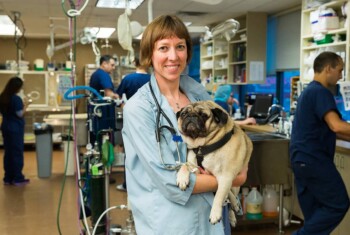February marks National Pet Dental Health Month.
If you are a pet owner, you are no stranger to that cringe of revulsion when your dog or cat breathes or yawns near your face.
Maybe your pet yelps when attempting to gnaw on a hard treat, chews on one side of their mouth, or noticeably drops food while eating. These may be signs your pet is suffering from a form of gum disease—most commonly, periodontal disease. Periodontal (gum) disease is a severe infection of the soft tissues that hold teeth in place and is a result of plaque buildup—a sticky film of bacteria—on teeth.
Dr. Donnell Hansen of BluePearl Specialty and Emergency Pet Hospital in Eden Prairie and Arden Hills, Minnesota explains that while many studies suggest there is a correlation between periodontal disease and systemic diseases in humans (a similar phenomenon exists in pets), she worries more about the consequences of pain and infection that periodontal disease brings.
The truth is most patients won’t show signs of oral pain and will continue to go on playing and eating. They just don’t have a way to vocalize their pain,” remarked Dr. Hansen, DAVDC, Board Certified in Veterinary Dentistry and Oral Surgery, BluePearl, Eden Prairie/ Blaine. “My biggest concern with periodontal disease is that while you may see symptoms and there can be hints for oral concern, most indicators are hidden. Regardless of how the mouth looks, it is important to have annual dental examinations that include x-rays.”
At Home Tips to Help Determine Your Pet’s Oral Health
- Lift their lip and examine (if they will let you). Do you see any redness or swelling of the gums? Do you see any brown plaque, tartar, blood, worn, loose or missing teeth? Keep in mind that while there may not be any visible indicators, issues can still be present below the gum line. Brush your pet’s teeth with toothpaste daily and opt for dental treats. Avoid hard bones, pig ears, elk antlers, and hard rubberized chew toys. If you are unsure if a treat or toy is too hard, Dr. Hansen suggests doing a dent test. Use your thumbnail to try to dent the toy/treat. If it does not dent, it is liable to break a tooth.
- Check their breath. Does your pet’s breath smell consistently foul (like rotten eggs)? There may be more going on than just bad breath. Gum disease—resulting from bacteria and plaque buildup—can cause redness, swelling of gums, and/or bad breath. Over time, gum disease can harm your pet’s teeth and jaw, and is one of the major causes of tooth decay. Talk to your veterinarian if you notice any persistent unusual odor, especially if it is not directly related to something your pet ate. If your vet rules out any underlying conditions, learning how to get rid of dog breath at home could solve the problem.
- Watch for drooling. Dental problems such as periodontal disease and tooth abscesses often cause pets to drool, drop food, and/or chew to one side of their mouth. Look out for these signs, as they could indicate disease or another health issue that may be preventing your pet from swallowing saliva.
- Watch for pawing at their mouth. Is your cat or dog pawing, scratching or continually licking certain areas in their mouth? While this might indicate teething in younger pets, in middle to older age pets, this could be a sign of a more serious problem like dental pain or nerve a disorder. Check your pet’s teeth and gums for something that could be bothering them, such as cuts from chewing on a hard bone or treat, or pieces of food. If there are no obvious annoyances, call your veterinarian to schedule an appointment.
- Look out for changes in eating habits. Unexpected changes in your pet’s appetite and weight may be a cause for concern, especially if they are reluctant to eat their normal food and/or treats. Food aversion and weight loss can also be sign of advanced dental disease that is causing chronic problems in the liver, heart, and kidneys. If possible, keep note of your pet’s eating patterns and speak to your veterinarian if their appetite has drastically decreased, particularly if there have been no changes to diet.
Preventative Care is Key
Dr. Hansen says the problem can escalate when bacteria from plaque and tartar spreads deeper into the gum line, causing inflammation in and around the mouth. For this reason, Dr. Hansen says preventative care, such as daily brushing and annual dental examinations, is key.
By maintaining a healthy mouth, we do notice that helps with other inflammatory diseases. It is particularly helpful in maintaining diabetic regulation,” explained Dr. Hansen. “Preventative care rather than reactive treatment is the goal. Start brushing your pet’s teeth and playing with their mouth when they are young. This will help them become ‘vet ready,’ which simply means they are desensitized to the processes involved in dental care, like looking inside their mouth and ears.”
Silent Sufferers
Because pets are silent sufferers, it is difficult for pet owners to determine if their pet is in pain and where that pain is coming from.
Pets are masters at hiding illness, so periodontal disease may go unnoticed until reaching an advanced stage. That is why it is critical that pet owners see a veterinarian for annual dental checkups, and a veterinary dentist for ultrasonic cleanings, which are essential to keeping gums and dental bone healthy and clean,” Dr. Hansen said. “Remember; periodontal disease is both preventable and reversible, but will worsen as your pet grows older if effective preventive measures aren’t taken. Early detection and treatment are vital and can prevent your pet from experiencing unnecessary pain and infection.”
Talk with your family veterinarian about scheduling an annual dental exam that is appropriate for your pet’s breed, age, and health condition.


